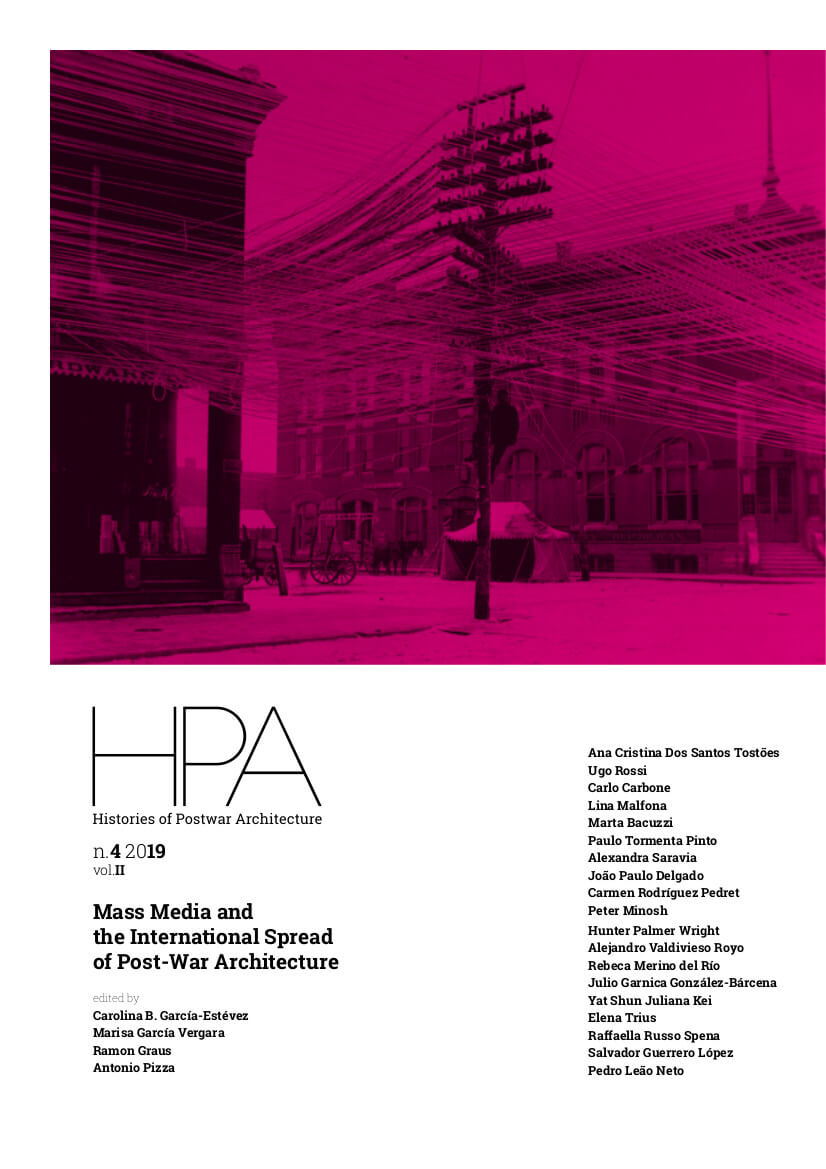New Brutalism and the Myth of Japan
DOI:
https://doi.org/10.6092/issn.2611-0075/9633Keywords:
New Brutalism, Japan, Architectural Design magazine, Standardised Architecture, Roland BarthesAbstract
This paper seeks to shed new lights on the New Brutalism through re-orienting attention to the repeated evocations of Japan in Alison and Peter Smithson’s writings since the 1950s. In these articles, the Smithsons did not only present Japanese architectural tradition as a yardstick of the Modern Movement and hence New Brutalism, but also took pride in the fact that their understandings of Japanese culture were from the mass media. This study examines how New Brutalism was simultaneously shaped by mass media’s post-war media boom and their portrayal of Japan. It suggests that Japan had several efficacies for New Brutalism, including as an inspiration for mass-produced architecture and mass-produced culture. The problems associated with their references to Japan will also be considered.
Downloads
References
Architectural Design. 1957. “Opinion: New Brutalism,” 1957.
Architectural Forum. 1947. “Defense of the Imperial Hotel,” January 1947.
Architectural Review. 1947. “Japanese Living Room,” June 1947.
Banham, Reyner. 1955. “The New Brutalism.” Architectural Review, December 1955.
———. 1966. The New Brutalism: Ethic or Aesthetic? London: Academy Press.
Barthes, Roland. 1972. Mythologies. 2nd ed. New York: THE NOONDAY PRESS.
Ben-Ami, Daniel. 1995. “Is Japan Different?” In Cultural Difference, Media Memories: Anglo-American Images of Japan, edited by Philip Hammond, 1–22. London: Cassell.
Benedict, Ruth. 1946. The Chrysanthemum and the Sword: Patterns of Japanese Culture. Boston: Houghton Mifflin Co.
Benjamin, Walter. 1978. Reflections. Essays, Aphorisms, Autobiographical Writings. Edited by Peter Demetz. New York: Schocken.
Bullock, Nicholas. 2002. Building the Post-War World: Modern Architecture and Reconstruction in Britain. London: Psychological Press.
Crosby, Theo, ed. 1961a. The Architecture of Technology. Whitefrairs: London.
———. 1961. “Conclusion: 1961 UIA Congress.” Architectural Design, November 1961.
———. 1990. “Night Thoughts of a Faded Utopia.” In The Independent Group: Postwar Britain and the Aesthetics of Plenty, 197–99. Cambridge, MA: MIT Press.
Crosby, Theo, Alison Smithson, and Peter Smithson. 1955. “The New Brutalism.” Architectural Design, January 1955.
Crowther, Bosley. 1954. “The Screen in Review.” The New York Times, December 14, 1954.
Curtis, Barry. 1990. “From Ivory Tower to Control Tower.” In The Independent Group: Postwar Britain and the Aesthetics of Plenty, 221–27. Cambridge, MA: MIT Press.
Glendinning, Miles. 2009. “Cold-War Conciliation: International Architectural Congress in the Late 1950s and Early 1960s.” The Journal of Architecture 14: 197–217.
Hammond, Philip, ed. 1997. Cultural Difference, Media Memories: Anglo-American Images of Japan. Cassell.
Henry A., Million. 1972. “Rudolf Wittkower, ArchitecturaPl Rinciples in the Age of Humanism: Its Influence on the Development and Interpretation of Modern Architecture.” Journal of the Society of Architectural Historians 31 (2): 83–91.
Jencks, Charles. 1977. The Language of Post-Modern Architecture. Rizzoli: New York.
Johnson, Philip. 1954. “School at Hunstanton, Norfolk, by Alison and Peter Smithson.” Architectural Review, September 1954.
Johnston, Andrew. 1998. “Rashomon.” Time Out New York, February 26, 1998.
Kousidi, Matina. 2016. “Through the Lens of Sigfried Giedion. Exploring Modernism and the Greek Vernecular in Situ.” RIHA Journal, no. 0136 (July). https://www.riha-journal.org/articles/2016/0131-0140-special-issue-southern-modernisms/0136-kousidi.
Le Corbusier. 1954. The Modulor: A Harmonious Measure to the Human Scale Universally Applicable to Architecture and Mechanics. London: Faber & Faber.
Massey, Anne. 2013. Out of the Ivory Tower: The Independent Group and Popular Culture. Manchester: Manchester University Press.
Neumann, Eva-Marie. 1996. “Architectural Proportion in Britain 1945–1957.” Architectural History, no. 39: 197–221.
Newsom, Samuel. 1946. “Secrets of Japanese Gardens.” Asia and the Americas, June 1946.
Parnell, Stephen. 2012. “Brute Forces.” Architectural Review, June 2012.
Pentagram. 1978. Living by Design. Pentagram: London.
Perriand, Charlotte. 1946. “Une Habitation Au Japon.” Techniques et Architecture, 1946.
RIBA Journal. 1957. “Report of a Debate,” 1957.
Rowe, Colin. 1947. “The Mathematics of the Ideal Villa.” Architectural Review, March 1947.
Rowntree, Diana. 2003. “Peter Smithson.” The Guardian, March 3, 2003, sec. Obituaries. https://www.theguardian.com/society/2003/mar/08/urbandesign.artsobituaries.
Saint, Andrew. 1990. “Review: Houses from the Factory: System Building and the Welfare State 1942-74.” Construction History, no. 6: 85–89.
Sato, Tadao. 1994. “Japanese Cinema and the Traditional Arts: Imagery, Technique and Cultural Context.” In Japanese Cinema and the Traditional Arts: Imagery, Technique and Cultural Context, by Linda Ehrlich and David Desser, translated by Ann Sherif, 165–86. Austin: University of Texas Press.
Sharp, Jasper. 2003. “Japanese Widescreen Cinema: Commerce, Technology and Aesthetics.” PhD Dissertation, Sheffield: Sheffield University.
Smithson, Alison, and Peter Smithson. 1956. “But Today We Collect Ads.” Ark: Journal of the Royal College of Art, November 1956.
———. 1957. “The New Brutalism; Alison and Peter Smithson Answer the Criticism on the Opposite Page.” Architectural Design, April 1957.
———. 1961. “The Rebirth of Japanese Architecture.” Architectural Design, February 1961.
———. 1973. Without Rhetoric: An Architectural Aesthetic, 1955-1972. Latimer New Dimension: London.
Smithson, Peter. 1953. “House in SoHo, London.” Architectural Design, December 1953.
———. 1961. “Untitled.” In Architecture of Technology, edited by Theo Crosby, n.p. London: Whitefrairs Press.
———. 1977. “AD Profile: Milbank.” Architectural Design, 1977.
Smithson, Peter, Catherine Spellman, and Karl Unglaub. 2005. Peter Smithson: Conversations with Students. NJ, Princeton: Princeton Architectural Press.
Soper, Alexander. 1955. “Book Review: The Lesson of Japanese Architecture. By Jiro Harada.” The Journal of Asian Studies 15 (1): 127–28.
Taut, Bruno. 1936. The Fundamentals of Japanese Architecture. Kokusai Bunka Shinkokai: Tokyo.
Van den Heuvel, Dirk. 2015. “Between Brutalists. The Banham Hypothesis and the Smithson Way of Life.” The Journal of Architecture 20 (2): 293–308.
Vidler, Anthony. 2010. “Another Brick in the Wall.” October 136: 105–32.
Weight, Richard. 2004. “Losing The Peace: Germany, Japan, America and the Shaping of British National Identity in the Age of Affluence.” In An Affluent Society? Britain’s Post-War “Golden Age” Revisited, by Lawrence Black and Hugh Pemberton, 203–22. London: Routledge.
Wittkower, Rudolf. 1998. Architectural Principles in the Age of Humanism. 3rd ed. Wiley: London.
Downloads
Published
How to Cite
Issue
Section
License
Copyright (c) 2019 Yat Shun Juliana Kei
The copyrights of all the texts on this journal belong to the respective authors without restrictions. Authors grant to the journal a non-exclusive right to publish their work.
This journal is licensed under a Creative Commons Attribution 4.0 International License (full legal code).
See also our Open Access Policy.






